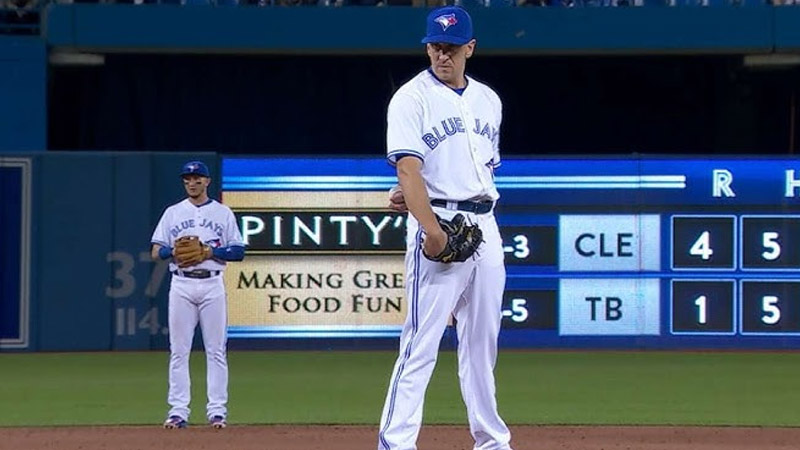Baseball, known for its rich history and unique set of rules, occasionally unveils rare talents that leave fans in awe. One such phenomenon is the ambidextrous pitcher – a pitcher with the incredible ability to throw with both their left and right arms.
The ambidextrous pitcher rule, a fascinating aspect of the game, governs how these skilled players can showcase their talents on the mound. In this blog post, we delve into the ambidextrous pitcher rule in baseball, exploring the guidelines, its significance, and the impact it has on the sport.
Whether you’re a die-hard baseball fan or new to the game, this post will provide a deeper understanding of the remarkable world of ambidextrous pitching. So, stay focused.
What is the Ambidextrous Pitcher Rule in Baseball?
The Ambidextrous Pitcher Rule in baseball governs the actions and restrictions placed on pitchers who possess the unique ability to throw with both their left and right arms.
An ambidextrous pitcher is a rare and fascinating phenomenon in the sport, capable of switching hands to throw pitches to batters from either side of the plate.
The rule ensures fair play, provides clarity on the pitcher’s actions, and prevents any potential advantages or manipulations arising from this extraordinary skill.
Ambidextrous Pitcher Rule in MLB

Source: mlb.com
In Major League Baseball (MLB), the Ambidextrous Pitcher Rule is governed by the Official Baseball Rules, which provide clear guidelines to maintain fairness and consistency on the field.
According to Rule 5.07 (d), an ambidextrous pitcher, equipped with the remarkable ability to throw with both their left and right arms, must declare which arm they intend to use before facing each batter.
This declaration is crucial as it sets the tone for the entire at-bat and ensures that both the pitcher and the batter are aware of the pitcher’s throwing arm.
The Declaration Process
Before facing a new batter, the ambidextrous pitcher must clearly communicate to the home plate umpire and the opposing team which arms they will use to deliver pitches during that specific at-bat.
This declaration must be made openly and unequivocally, leaving no room for ambiguity. The umpire records the pitcher’s declaration to avoid any confusion during the at-bat.
Exclusive Use of the Declared Arm
Once the pitcher has made their declaration, they are bound by the rule to exclusively use the arm they announced throughout the entire at-bat.
This means that if the ambidextrous pitcher begins the at-bat as a left-handed pitcher, they cannot switch to their right hand to complete the at-bat, even if the batter switches sides of the plate (commonly referred to as a switch-hitter).
The pitcher’s declared arm becomes legally locked for the duration of that specific at-bat.
Impact on Strategic Decisions
The ambidextrous pitcher rule profoundly influences the strategic decisions made by both the pitcher and the batter. For the pitcher, it requires thoughtful consideration and understanding of the batter’s tendencies and weaknesses from each side of the plate.
The decision of which arm to use is often based on the hitter’s batting statistics, historical performance against pitchers of the same hand, and the pitcher’s personal confidence in their pitches from both sides.
Fairness and Clarity
The rule fosters fairness and clarity in the game by removing any potential uncertainty surrounding the pitcher’s intentions. Batters can prepare themselves appropriately based on the announced throwing arm, allowing them to adjust their batting stance and strategy accordingly.
Likewise, the pitcher knows that they must commit to the declared arm, ensuring that both parties are on an equal footing during the at-bat.
A Rare and Spectacular Sight
While ambidextrous pitchers are exceedingly rare in baseball, their appearances on the mound are nothing short of extraordinary and captivating. When an ambidextrous pitcher takes the mound, it becomes a special moment that draws attention from fans, players, and the media alike.
Their ability to throw effectively from both sides adds an element of surprise and intrigue to the game, making it a remarkable spectacle to behold.
Origin of the Ambidextrous Pitcher Rule

Source: sportscasting.com
The introduction of the Ambidextrous Pitcher Rule can be traced back to baseball’s commitment to fairness, sportsmanship, and maintaining a level playing field for all players.
The rule was established to address a potential loophole that an ambidextrous pitcher could exploit, thereby ensuring that the game remains both competitive and enjoyable for players and fans alike.
Avoiding Strategic Advantages
Baseball has always been a game of strategy and tactics. An ambidextrous pitcher’s unique ability to throw with both arms presents an unprecedented advantage if not properly regulated.
Without the rule, an ambidextrous pitcher could switch arms mid-plate appearance, confounding batters and catching them off-guard. Such a maneuver could disrupt a batter’s rhythm and timing, potentially leading to an unfair advantage for the pitcher.
Confusion for Batters
Batters rely on their ability to anticipate the type of pitch they will face based on the pitcher’s arm angle. An ambidextrous pitcher switching arms during an at-bat would present an unexpected challenge for the batter.
This could lead to hesitation, compromised decision-making, and potentially reduce the batter’s chances of making solid contact with the ball.
Leveling the Playing Field
To maintain the integrity of the game, it was essential to establish a rule that would prevent any strategic exploitation and keep the playing field level. By mandating ambidextrous pitchers to declare their pitching arm beforehand, the rule provides batters with clarity and predictability.
This way, batters can prepare for what is to come and face the pitcher with a fair understanding of what pitches to expect.
Clear Expectations for Players
The Ambidextrous Pitcher Rule sets a clear standard for how ambidextrous pitchers must conduct themselves during at-bats. By ensuring that both batters and pitchers are on the same page before each plate appearance, the rule fosters a sense of consistency and fairness in the game.
Upholding Sportsmanship
At its core, baseball values sportsmanship and fair play. The Ambidextrous Pitcher Rule aligns with these principles by preventing any potential manipulations that could compromise the integrity of the game.
It reinforces the idea that success on the diamond should be earned through skill, strategy, and adherence to the established rules.
Who Are the Ambidextrous Hitters and Pitchers?
Check out the following section to know about some of the popular ambidextrous hitters and pitchers.
Ambidextrous Pitchers
Ambidextrous pitchers, possessing the rare ability to throw with both their left and right arms, are an extraordinary sight in the world of baseball.
While they are exceptionally rare, a few notable ambidextrous pitchers have left an indelible mark on the sport.
1. Pat Venditte
Pat Venditte is perhaps the most well-known ambidextrous pitcher in modern baseball history. During his career in Major League Baseball (MLB), Venditte gained significant attention for his unique skill set.
Venditte became the embodiment of the ambidextrous pitcher rule itself as he utilized both arms interchangeably during his appearances on the mound.
A switch pitcher, Venditte created fascinating scenarios on the field, facing batters from both sides of the plate without changing pitchers. His ambidextrous abilities made him a fan favorite and added a thrilling dimension to the game whenever he took the mound.
2. Greg Harris
Another noteworthy ambidextrous pitcher in MLB history is Greg Harris. While he wasn’t as renowned as Pat Venditte, Harris etched his name in the record books by accomplishing a remarkable feat.
In a game on September 28, 1995, as a member of the Montreal Expos, Harris pitched with both his left and right arms, becoming the first and only player to do so in a single MLB game.
Harris’ exceptional talent and versatility showcased the uniqueness of ambidextrous pitchers and demonstrated the challenges they could present to opposing hitters.
Ambidextrous Hitters
Ambidextrous hitters, players who can effectively bat from both sides of the plate, are even rarer than ambidextrous pitchers. Their ability to switch-hit provides them with a strategic advantage, as they can adjust their stance based on the pitcher’s arm and the situation on the field.
While few in number, some players have showcased their ambidextrous hitting skills in the history of baseball.
1. Mickey Mantle
Mickey Mantle, an iconic figure in baseball history, was one of the most prominent switch-hitters of all time. As a member of the New York Yankees, Mantle dominated the game during the 1950s and 1960s.
His ability to hit with power and consistency from both sides of the plate earned him a spot in the Hall of Fame and solidified his legacy as one of the greatest players in baseball history.
2. Yasmani Grandal
A more recent example of an ambidextrous hitter is Yasmani Grandal, a skilled catcher who has played for several teams in MLB. Grandal’s switch-hitting prowess has been an asset to his teams, allowing him to adapt to different pitchers and pitch sequences effectively.
His ambidextrous hitting abilities have made him a valuable asset in the lineup, adding versatility and strategic options for his team’s offensive strategy.
Penalties Against Breaking Ambidextrous Pitcher Rule
The penalties for breaking the Ambidextrous Pitcher Rule are an essential aspect of ensuring compliance and maintaining fairness in the game. While the rule is relatively straightforward, any violation can potentially disrupt the balance between the pitcher and batter of a game.
Umpires play a crucial role in enforcing the rule and ensuring that both teams adhere to its guidelines.
Warning to the Pitcher and Team
In less severe cases where the violation is unintentional or perceived as a one-time mistake, the umpire may issue a warning to the ambidextrous pitcher and their team.
The warning serves as a reminder and cautionary measure, alerting them to the importance of adhering to the rule for the remainder of the game.
Ejection from the Game
If the violation is deemed more deliberate or the ambidextrous pitcher repeats the offense after receiving a warning, the umpire may decide to eject the pitcher from the game. This harsher penalty is meant to send a strong message about the seriousness of adhering to the rule and discouraging any further breaches.
Disciplinary Actions from the League
In extreme cases where a violation is severe, intentional, or part of a pattern of rule-breaking, the league may take further action. Disciplinary actions may include fines, suspensions, or other sanctions against the player and, in some cases, the team.
The league’s involvement ensures that players and teams are held accountable for adhering to the rules and upholds the integrity of the sport.
It’s essential to note that umpires exercise discretion when applying penalties, taking into account the context and intent behind the violation.
Significance of the Ambidextrous Pitcher Rule in Baseball
The Ambidextrous Pitcher Rule holds significant importance in baseball due to its impact on fair play, strategic balance, and sportsmanship.
Fair Play and Sportsmanship
By mandating that an ambidextrous pitcher declares their pitching arm before each batter, the rule ensures that batters know what to expect during each at-bat. This promotes fair play, as batters have an equal opportunity to prepare and adjust their approach based on the declared arm.
Strategic Balance
Without the rule, an ambidextrous pitcher could exploit the element of surprise, potentially disrupting a batter’s rhythm or timing. By requiring the declaration, the rule adds an element of predictability and strategy to the game, enhancing the competition between pitcher and batter.
Safety and Preventing Unfair Advantages
The rule also serves as a safety measure, preventing potential confusion or hazardous situations on the field that could arise from a pitcher switching arms mid-at-bat.
Additionally, it prevents the pitcher from gaining an unfair advantage by keeping batters guessing and altering their approach based on the pitcher’s hand.
Rarity and Entertainment Value
The infrequency of ambidextrous pitchers adds to the intrigue and entertainment value of the game. When an ambidextrous pitcher takes the mound, it becomes a captivating spectacle for fans and a unique challenge for batters, making the game all the more exciting.
FAQs
What is the ambidextrous pitcher rule in baseball?
The ambidextrous pitcher rule in baseball requires a pitcher with the ability to throw with both their left and right arms to declare which arm they will use before facing each batter.
Once the declaration is made, the pitcher must pitch exclusively with the chosen arm during that particular at-bat, avoiding the possibility of switching arms mid-at-bat to gain an unfair advantage.
Why was the ambidextrous pitcher rule introduced?
The rule was introduced to provide clarity and fairness on the field. Without the rule, an ambidextrous pitcher could potentially confuse batters by switching arms during an at-bat, creating an unfair advantage.
By requiring the pitcher to declare their arm beforehand, the rule ensures that both batters and pitchers have clear expectations during each plate appearance.
Are ambidextrous pitchers common in baseball?
No, ambidextrous pitchers are exceedingly rare in baseball. Only a handful of players in the history of the sport have showcased this extraordinary skill at the professional level. The rarity of ambidextrous pitchers adds to the fascination and excitement when they take the mound.
Are there any ambidextrous hitters in baseball?
While ambidextrous pitchers are rare, ambidextrous hitters are even scarcer. Very few players possess the ability to effectively bat from both sides of the plate. Examples of ambidextrous hitters include Hall of Famer Mickey Mantle and more recently, Yasmani Grandal.
What penalties exist for breaking the ambidextrous pitcher rule?
If an ambidextrous pitcher violates the rule by failing to declare their pitching arm before facing a batter, umpires may issue warnings or penalties.
Depending on the severity and intent of the violation, penalties can range from warnings to ejections from the game, and in some cases, disciplinary actions from the league.
End Call
The ambidextrous pitcher rule adds a unique dimension to the world of baseball, celebrating the extraordinary skills of rare talents. While ambidextrous pitchers are few and far between, their impact on the game is substantial.
The rule fosters fairness, strategic balance, and sportsmanship, ensuring that both batters and pitchers know what to expect during each at-bat. Moreover, the rare appearance of an ambidextrous pitcher on the mound creates a captivating spectacle for fans and a challenging scenario for batters.
As baseball continues to evolve, the ambidextrous pitcher rule remains a captivating aspect that adds to the charm and intrigue of America’s beloved pastime. Best of luck.







